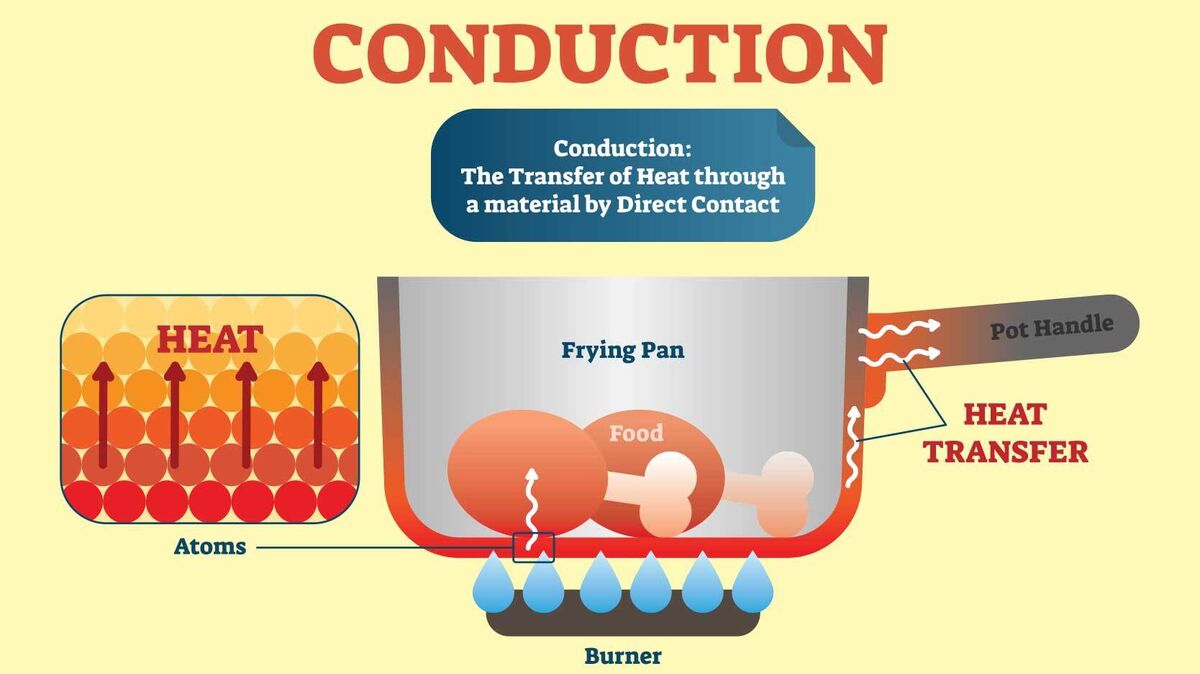
Conduction is the movement of heat or electricity through a material without any perceptible motion of the material. Discover more details about real-life conduction and review some examples of conduction.
Conduction Defined in Simple Terms
Conduction is one of the ways that heat can transfer from one place to another. Conduction occurs when energy is transferred from one atom or object to another. It takes place through either heat or electricity. Conduction can occur in liquid, gaseous or solid objects.
- For conduction to take place between two objects, they must be touching each other.
- For conduction to occur between atoms within the same object, they must also be touching (or nearly touching).
When conduction occurs, it doesn't cause the object(s) to move in a way that people can perceive. This is because conduction does not cause materials to be displaced.
Everyday Examples of Heat or Thermal Conduction
Heat conduction and thermal conduction mean the same thing. As molecules heat up, they begin to vibrate, which causes them to transfer kinetic energy to other molecules they come in contact with.
- You can warm your back muscles with a heating pad. As the pad heats up, it transfers heat to the part of your body that it is in contact with.
- The heat from a hot liquid makes the cup itself hot. If you grab a cup that has hot coffee, tea or broth in it, the cup itself will be hot and your hands will feel it.
- If you are cold and someone holds you to warm you, the heat is being conducted from their body to yours.
- If you leave a metal spoon propped up in a pot, it will become hot from the boiling water inside the pot.
- Chocolate candy in your hand will eventually melt as heat is conducted from your hand to the chocolate.
- When ironing a piece of clothing, the iron is hot and the heat is transferred to the clothing.
- If you stoke a fire in the fireplace with a poker and leave the poker in the fire, the poker will become very hot.
- A heat exchanger uses a hot fluid to conduct heat to a cooler fluid without the two actually coming into direct contact.
- If you touch a hot stove, heat will be conducted to your finger and your skin will burn.
- Sand can conduct heat. This is why walking on the beach on a hot summer day will warm your feet.
- It's important to protect your dog's paws when walking on hot asphalt or concrete. They conduct heat to your pet's feet just as they would to yours.
- Light bulbs give off heat. If you touch a light bulb when it is on, your hand will get burned.
There are many additional examples of heat conduction beyond the ones listed above.
Everyday Electrical Conduction
Electrical conduction occurs when particles that are electrically charged move through some type of medium to produce electrical energy.
- The wires in your home conduct electricity and allow lights to come on when you flip the switch.
- When you turn on your computer or any other electric or battery-operated devices or appliances, electrical conduction is what makes them function.
- With a landline phone, sound waves are converted into electricity that is conducted over wires to the other person's phone. There, it is converted back to sound waves.
- Lightning rods are installed on buildings to attract lightning to hit them and conduct their energy down into the ground via attached wires rather than damaging the structure.
- Hearts have their own naturally occurring electrical conduction system. When a heart beats, its electrical signals cause the heart to beat in an appropriate rhythm.
- If the electrical system in someone's heart doesn't work properly, the person may need to have a pacemaker installed to simulate conduction.
- The ions in water cause it to conduct electricity. This is why it is important to avoid swimming during a lightning storm; if lightning hits the water, anyone in it risks electrocution.
- This also holds true with electrical appliances and water. If a plugged-in blow dryer (or any other electric item) falls into a tub or sink filled with water, do not touch it. The water would conduct the electricity such that touching the device could result in electrocution.
- When table salt is dissolved in water, it can conduct electricity. That is because the water separates the sodium ions from the chlorine ions apart.
Materials that Are Good Conductors
Certain materials work very well as conductors.
- aluminum
- brass
- bronze
- copper
- gold
- graphite
- iron
- mercury
- steel
- silver
More Ways Heat Can Be Transferred
Conduction is one of the three ways that heat can be transferred. It can also be transferred through convection and radiation. While you're discovering examples of conduction, go ahead and learn more about these other mechanisms for heat transfer. Start by exploring some examples of convection. Then, review some examples of radiation in daily life.